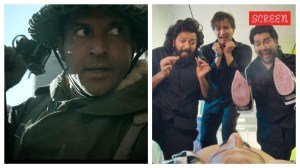Click here to follow Screen Digital on YouTube and stay updated with the latest from the world of cinema.
Sundance Offers a Web Afterlife for Its Alumni
What happened was,Tom Noonan won at the Sundance Film Festival,and his movie disappeared.
What happened was,Tom Noonan won at the Sundance Film Festival,and his movie disappeared.
The film barely sold, Mr. Noonan said of What Happened Was,which earned the festivals 1994 grand jury drama prize. And then the company went bankrupt. The film came out on video,but not DVD. It was buried in some library. I tried repeatedly to buy it back from people,but it took real strong-arming to even get the lawyers to call me, Mr. Noonan explained life in indie limbo.
Deals eventually expire,and rights revert; Mr. Noonan,the well-known character actor (Damages,Hell on Wheels),got his film back recently,and the timing couldnt have been better: a wormhole has opened up between Sundance Past and the Online Present. Through it,films seemingly lost in time or swallowed up by the gaping maw of bad distribution deals,or no distribution deals might find commercial redemption.
Thanks to a recent arrangement between the Sundance Institute,which operates the festival,and the Manhattan distributor New Video,six Web homes Amazon,Hulu,Netflix,iTunes,YouTube and SundanceNOW are making Mr. Noonan’s movie,and any other eligible Sundance film,available for streaming online. The option is open to every film ever shown at the festival,or brought to a Sundance lab,or given a Sundance grant. Filmmakers dont surrender their rights. They (17 so far,with thousands of potential participants) can opt to go with any or all of the half-dozen sites. In essence,it means a guaranteed distribution.
Erin Greenwell said that before she began making My Best Day,part of the festival’s Next section (it begins on January 19),I promised my producer that if I had to personally go from town to town with a duffle bag of DVDs,I would.
For others the implications are more profound. Hal Hartley,director of indie landmarks like The Unbelievable Truth and Simple Men,was already involved with Sundance. He was financing his next film Meanwhile through the institutes alliance with the crowd-funding site Kickstarter,when he was contacted by Chris Horton,the institutes associate director of artist services,which assists filmmakers in financing and distribution.
Mr. Hartley called the financial arrangement exceptional. With all the legalities involving rights,he said,you need a Kickstarter campaign just to hire the lawyers.
Robert Redford,who in 1984 founded the institute (which took over the festival in 1985),says,Theres a whole category of orphan films that we think are quite good,but they don’t necessarily get picked up by distributors,more mainstream in their thinking.
Given the cacophonous nature of current pop culture,Sundance is expanding the role it has always played: curator. I kind of baulk at the word brand. But it gives us an imprimatur to cross into new territory with some kind of value-added appeal. Sundance Institute’s executive director,Keri Putnam,says,What the market doesn’t need is another distributor. We needed to offer a helping hand,to be an access road.


- 01
- 02
- 03
- 04
- 05
































